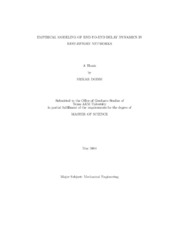| dc.description.abstract | Quality of Service (QoS) is the ability to guarantee that data sent across a network
will be recieved by the desination within some constraints. For many advanced applications, such as real-time multimedia QoS is determined by four parameters--end-to-end delay, delay jitter, available bandwidth or throughput, and packet drop or
loss rate. It is interesting to study and be able to predict the behavior of end-to-end
packet delays in a Wide area network (WAN) because it directly a??ects the QoS of
real-time distributed applications. In the current work a time-series representation of
end-to-end packet delay dynamics transported over standard IP networks has been
considered. As it is of interest to model the open loop delay dynamics of an IP WAN,
the UDP is used for transport purposes. This research aims at developing models
for single-step-ahead and multi-step-ahead prediction of moving average, one-way
end-to-end delays in standard IP WAN??s.
The data used in this research has been obtained from simulations performed using
the widely used simulator ns-2. Simulation conditions have been tuned to enable
some matching of the end-to-end delay profiles with real traffic data. This has been
accomplished through the use of delay autocorrelation profiles. The linear system
identification models Auto-Regressive eXogenous (AR) and Auto-Regressive Moving
Average with eXtra / eXternal (ARMA) and non-linear models like the Feedforwad
Multi-layer Perceptron (FMLP) have been found to perform accurate single-step-ahead predictions under varying conditions of cross-traffic flow and source send rates.
However as expected, as the multi-step-ahead prediction horizon is increased, the
models do not perform as accurately as the single-step-ahead prediction models. Acceptable
multi-step-ahead predictions for up to 500 msec horizon have been obtained. | en |


